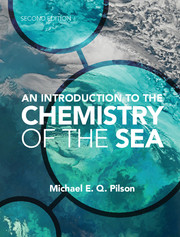Book contents
- Frontmatter
- Contents
- Preface
- Acknowledgments
- 1 Introduction
- 2 The water in seawater
- 3 Salinity, chlorinity, conductivity, and density
- 4 Major constituents of seawater
- 5 Simple gases
- 6 Salts in solution
- 7 Carbon dioxide
- 8 Nutrients
- 9 Trace metals and other minor elements
- 10 Radioactive clocks
- 11 Organic matter in the sea
- 12 Anoxic marine environments
- 13 Exchanges at the boundaries
- 14 Chemical extraction of useful substances from the sea
- 15 Geochemical history of the oceans
- Appendix A The chemical elements
- Appendix B Symbols, units, and nomenclature
- Appendix C Physical properties of seawater
- Appendix D Gases
- Appendix E Carbon dioxide
- Appendix F Dissociation constants and pH scales
- Appendix G Solubility of calcium carbonate
- Appendix H Effects of pressure
- Appendix I Radioactive decay
- Appendix J Geochemical reservoirs, and some rates
- Appendix K Sound absorption
- Epilogue
- Questions for chapters
- Glossary
- References
- Index
- Miscellaneous end matter
Appendix A - The chemical elements
Published online by Cambridge University Press: 05 February 2013
- Frontmatter
- Contents
- Preface
- Acknowledgments
- 1 Introduction
- 2 The water in seawater
- 3 Salinity, chlorinity, conductivity, and density
- 4 Major constituents of seawater
- 5 Simple gases
- 6 Salts in solution
- 7 Carbon dioxide
- 8 Nutrients
- 9 Trace metals and other minor elements
- 10 Radioactive clocks
- 11 Organic matter in the sea
- 12 Anoxic marine environments
- 13 Exchanges at the boundaries
- 14 Chemical extraction of useful substances from the sea
- 15 Geochemical history of the oceans
- Appendix A The chemical elements
- Appendix B Symbols, units, and nomenclature
- Appendix C Physical properties of seawater
- Appendix D Gases
- Appendix E Carbon dioxide
- Appendix F Dissociation constants and pH scales
- Appendix G Solubility of calcium carbonate
- Appendix H Effects of pressure
- Appendix I Radioactive decay
- Appendix J Geochemical reservoirs, and some rates
- Appendix K Sound absorption
- Epilogue
- Questions for chapters
- Glossary
- References
- Index
- Miscellaneous end matter
Summary
The periodic table of the elements is a comforting document. Within a few lines it manages to tame the seemingly chaotic world of matter into a reliable regularity. Each atom has its own pigeonhole, its place in the order of things. And the beauty of the periodic table is that the way it groups atoms allows some prediction of how they should behave. The noble gases such as helium remain aloof and unreactive,while the alkali metals can be expected to be silvery and reactive.
The Economist 374: Jan 15, 2005, P. 75.According to the present evidence from cosmological research, our universe began about 13.7 × 109 (± 0.2 × 109) years ago with the big bang. Calculation also suggests that only the three lightest elements were formed under the conditions at that time. Elements from about number 4 upwards could only be formed later, under the conditions in stars. Ordinary stars burn hydrogen and then successively heavier elements, and apparently can synthesize all the elements up to iron (number 26) by processes of thermonuclear fusion. All elements above iron must be made by several slow and rapid processes of neutron and proton addition as stars age and sometimes explode. The contents of stars are redistributed into space by gas streaming and under the remarkable conditions when they explode as novae or supernovae. The present mixture of elements on Earth (and in the Solar System generally) seems to require multiple processes for synthesis and thus seems to be the product of more than one generation or episode of star formation and explosion. Information from meteorites also suggests heterogeneity in source material.
- Type
- Chapter
- Information
- An Introduction to the Chemistry of the Sea , pp. 398 - 399Publisher: Cambridge University PressPrint publication year: 2012



